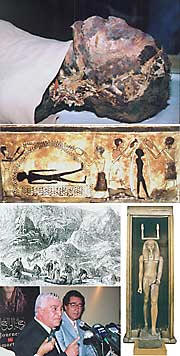|
The Second Mummies Room |
|
The second room is designed like a royal tomb with a vaulted ceiling and indirect, low lighting. It displays 11 mummies that are exhibited inside special showcases, each supplied with a small electronic device to observe and control the humidity level around the mummy minute by minute. The mummies belong to royal individuals of the 20th Dynasty like King Ramses III and priests of Amun who succeeded in ruling the southern half of Egypt as priest kings. These priest kings proclaimed Thebes as Egypt's religious capital and founded the 21st Dynasty. Among these priest kings is Pinudjem II, one of the Third Intermediate period rulers, who moved the earlier royal mummies to one of the caches. This room also displays three mummies of queens, such as Maat-Ka-Re. Dr. Zahi Hawass, Secretary General of the Supreme Council of Antiquities (SCA), said that the mummies exhibited in both rooms were among those discovered in 1881 in the first mummy cache at Deir El-Bahari (DB 320) on Luxor's west bank and in 1898 in the second cache of King Amenhotep IIís tomb (KV 35) in the Valley of the Kings. Both caches include mummies belonging to famous kings of the New Kingdom, including Tuthmosis III, Amenhotep III, and the last warrior pharaoh Ramses II as well as mummies of well-known queens and high priests of Amun. Hawass pointed out that all these mummies will be moved to a special hall already planned at the National Museum of Egyptian Civilization in Fustat where they will be displayed with more respect and for educational purposes rather than for thrills. Dr. Wafaa El-Sadiq, Director of the Egyptian Museum, Cairo, said that a major development project has been implemented in an attempt to acquaint visitors with the mummification process and its importance to the ancient Egyptians. Hence, panels for the first and second caches were inserted in the scenario along with a photo of King Amenhotep IIís tomb (KV 35) and other objects, such as linen shreds decorated with Osiris. To facilitate the visitorís tour, both rooms are linked to each other via a small corridor. For the first time, a catalogue with photographs has been published in English and Arabic, including photographs of the mummies on display and information concerning the mummification process, its rituals, and the deceased's journey into the Afterlife. The catalogue will be translated into French, German, and Japanese. |
 In
August 2006
In
August 2006